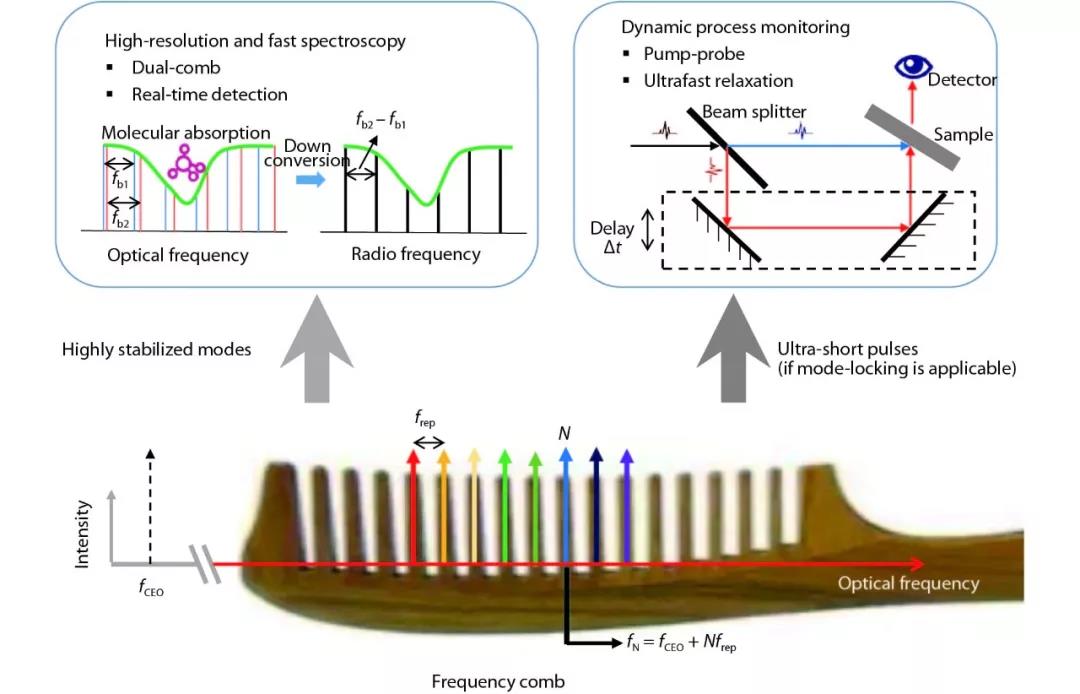博文
专家视点 | 黎华:半导体太赫兹光频梳
|
在最新出版的《半导体学报》2019年第5期上,中国科学院上海微系统与信息技术研究所黎华研究员介绍了采用半导体量子级联激光器实现太赫兹波段光频梳的研究工作。与传统飞秒激光泵浦产生太赫兹光频梳的方法不同,基于电泵浦的半导体激光器光频梳具有高功率和易集成等优势。另外,在工作频段方面,该半导体光频梳可以弥补光泵浦太赫兹光频梳难以企及的高频太赫兹波段。利用其高频率稳定性和短脉冲的独特优势,半导体太赫兹光频梳预期在高分辨光谱检测和时间分辨动力学研究方面具有重要应用。
Frequency combs[1, 2] consisting of equally-spaced frequency lines can be fully described by two frequencies, i.e., carrier offset (fCEO) and repetition rate (frep). Once the two frequencies are stabilized, the frequency comb is well defined. Frequency combs can be used for various applications, i.e., metrology, spectroscopy, timing, communications, absolute distance measurements, and so on, due to their two important characteristics, i.e., stabilized frequency lines and ultra-short optical pulses (if the mode-locking is obtained) as shown in Fig. 1. First of all, by employing the highly-stabilized frequency lines, a frequency comb can be used as a ruler to measure the absolute frequency. Furthermore, high-resolution and fast spectroscopies can be demonstrated using a dual-comb technique. Secondly, exploiting the ultrashort pulses generated from a frequency comb, it can be used to study the time-resolved dynamic process of carriers in semiconductor materials and molecules by using a pump-probe technique.

Figure1. (Color online) Frequency comb and its applications in spectroscopy and nonlinear dynamics of materials. fCEO and frepdenote the carrier envelope offset frequency and repetition frequency of a frequency comb, respectively. fb1 and fb2 are the two repetition frequencies of two combs and the difference between the two is Δf (= fb2 – fb1) which is the line spacing of the down-converted dual-comb spectrum.
Although the first demonstrations of frequency combs were developed in infrared wavelengths, the coherent comb operations in other wavelengths have been much in demand for various spectral applications. Here, we pay more attention to the terahertz frequency range (between 0.1 and 10 THz) which is also called “terahertz gap” in the entire electromagnetic spectrum due to the lack of efficient radiation sources in this frequency band. However, the terahertz frequency range is of great importance for practical applications since diverse characteristic absorption lines of gases and chemicals are located in this range. The electrically-pumped semiconductor-based terahertz quantum cascade laser (QCL)[3] featured by high output power, narrow far-field beam divergence, broad frequency coverage (1.2−5 THz) is an ideal candidate for achieving frequency comb operation in the terahertz regime.
Terahertz combs have been realized in QCLs by employing an active mode-locking or phase seeding technique assisted by femto-second lasers[4, 5]. However, such techniques require complex optics and electronics. So the frequency comb operation in free-running QCLs will be highly expected for various practical applications. In free-running QCLs, the comb formation is resulted from the locking mechanism induced by the four-wave mixing of the nonlinear cavity. But the four-wave mixing effect can be strongly perturbed by the group velocity dispersion. As the frequency becomes wider, the group velocity dispersion can result in the gradual change of the mode spacing with frequency, which is the main factor that prevents the laser from working as a frequency comb. Free-running terahertz QCL combs have been demonstrated by delicately considering the group velocity dispersion resulted from the frequency-dependent gain, waveguide, material, and intersubband absorptions[6, 7].
Currently, the application of terahertz QCL frequency combs is still in the preliminary stage. Although terahertz QCL combs have been successfully demonstrated in actively mode-locked or free-running lasers, the practical application of such combs for spectroscopy normally requires an implementation of dual-comb technique. The on-chip dual-comb terahertz source has been demonstrated using double-metal waveguide QCLs by employing a self-detection scheme[8]. However, due to the cryogenic working temperature of QCLs, the on-chip configuration doesn’t allow practical spectroscopic applications and it is generally used for characterize the frequency comb operation of lasers. Furthermore, a dual-comb based on two terahertz QCLs and a fast super-conducting hot electron bolometer has been proved to be feasible for terahertz spectroscopy[9].
Since the dual-comb spectroscopy shows advantages of high-resolution and fast data acquisition without a need of moving parts in the system over the traditional Fourier transform infrared (FTIR) spectroscopy, it will renovate the terahertz spectroscopy in the future. The spectral resolution is expected to be increased significantly by at least three orders from GHz (a typical value of a commercial FTIR) to MHz by employing the terahertz QCL dual-comb technique. The following two difficulties should be overcome for pushing the dual-comb technique for commercialization. First of all, the optical bandwidth of a single QCL-based frequency comb should be broadened for detecting absorption lines of various molecules. This is the main difficulty because the QCL is specially designed for narrow emission frequency. Moreover, as the frequency becomes wider, the dispersion compensation would becomes harder and harder. Secondly, the fine frequency tuning of QCL combs is critical for accurately measuring narrow absorption lines with high spectral resolutions. Therefore, external perturbations, for instance, by radio frequency modulation, is necessary to be employed.
It is worth mentioning that although optical pulses generated from terahertz QCL combs have been observed, it is still a way to go to use the terahertz pulses for nonlinear study in materials. Terahertz QCL combs are characterized by high output power. However, due to the high repetition rate of GHz level that is more than 1000 times larger than the femto-second laser pulses and much wider pulse duration of dozens of picoseconds resulted from the limited optical bandwidth, the peak power of a terahertz QCL comb is much weaker than that of a femto-second laser combs. Therefore, in the near future, to develop ultra-broadband terahertz QCL frequency combs with ultrashort pulse widths and low repetition rates is of great interest for spectroscopic and nonlinear studies.
Acknowledgements
This work was supported by the "Hundred-Talent" Program of Chinese Academy of Sciences, the National Natural Science Foundation of China (61875220, 61575214, 61404150, 61405233, and 61704181), the National Key R&D Program of China (2017YFF0106302 and 2017YFA0701005), and Shanghai Municipal Commission of Science and Technology (17YF1430000).
References
[1] Udem T, Holzwarth R, Hansch T W. Optical frequency metrology. Nature, 2002, 416, 233
[2] Kippenberg T J, Holzwarth R, Diddams S A. Microresonator-based optical frequency combs. Science, 2011, 332, 555
[3] Köhler R, Tredicucci A, Beltram F, et al. Terahertz semiconductor-heterostructure laser. Nature, 2002, 417, 156
[4] Oustinov D, Jukam N, Rungsawang R, et al. Phase seeding of a terahertz quantum cascade laser. Nat Commun, 2010, 1, 69
[5] Barbieri S, Ravaro M, Gellie P, et al. Coherent sampling of active mode-locked terahertz quantum cascade lasers and frequency synthesis. Nat Photonics, 2011, 5, 306
[6] Burghoff D, Kao T Y, Han N R, et al. Terahertz laser frequency combs. Nat Photonics, 2014, 8, 462
[7] Wang F H, Nong H, Fobbe T, et al. Short Terahertz Pulse generation from a dispersion compensated modelocked semiconductor laser. Laser Photonics Rev, 2017, 11, 1700013
[8] Rösch M, Scalari G, Villares G, et al. On-chip, self-detected terahertz dual-comb source. Appl Phys Lett, 2016, 108, 171104
[9] Yang Y, Burghoff D, Hayton D J, et al. Terahertz multiheterodyne spectroscopy using laser frequency combs. Optica, 2016, 3, 499

点击阅读黎华教授文章:
Semiconductor-based terahertz frequency combs
Hua Li
J. Semicond. 2019, 40(5), 050402
doi: 10.1088/1674-4926/40/5/050402

扫描二维码关注获得更多信息
https://blog.sciencenet.cn/blog-3406013-1180290.html
上一篇:专家视点 | 李孝峰:太阳能电池光电热模拟技术
下一篇:JOS编辑推荐 | 利用一种简便方法合成用于高效水裂解的超长Cu2O纳米线阵列